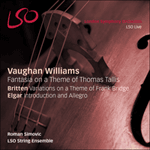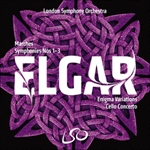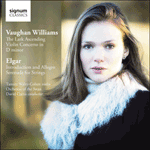
Welcome to Hyperion Records, a British classical label devoted to presenting high-quality recordings of music of all styles and from all periods from the twelfth century to the twenty-first.
Hyperion offers both CDs, and downloads in a number of formats. The site is also available in several languages.
Please use the dropdown buttons to set your preferred options, or use the checkbox to accept the defaults.

| LSO String Ensemble, Roman Simović (conductor)» More |
| London Symphony Orchestra, Sir Colin Davis (conductor)» More |
| Orchestra of the Swan, David Curtis (conductor)» More |
| Lyn Flechter (violin), Ann Lawes (violin), Timothy Pooley (viola), David Watkin (cello), The Hallé Orchestra, Sir Mark Elder (conductor)» More |
By 1905 Elgar, knighted the previous year, was at the height of his powers and of his reputation. With the advantage of hindsight we know that over the next few years he would produce The Kingdom, the First Symphony and the Violin Concerto; yet at the time, of course, he could have no such foresight or confidence in his muse. He was in one of those depressions that came on him after completing major works and before the next had been started. He was also suffering from indifferent health and under continuing financial pressures.
This is very much a London Symphony Orchestra work. The previous year Elgar had produced In the South, and now his friend A J Jaeger at Novello suggested he might write a brilliant work for strings for the then recently formed LSO. Elgar responded to the suggestion indicating that it would contain ‘a devil of a fugue’. The work was ready quickly and Elgar conducted it in the LSO’s concert at Queen’s Hall on 8 March 1905. The printed score is dedicated ‘To his friend Professor S S Sanford, Yale University, USA’, where Elgar went in the summer of 1905, to receive the award of an honorary degree.
The exhilaration and open-air character of the Introduction and Allegro was probably most deeply etched in the musical mind of the nation by the Ken Russell television film on Elgar, the most notable event which effectively re-launched Elgar as a major figure in the early 1960s. Written at a time when there were not many popular works for string orchestra heard at symphony concerts, the form of the piece is original: Elgar’s personal amalgam of elements from concerto grosso and sonata form with a vigorous fugue to mark the climax. We might imagine that Elgar’s imagination had been sparked by Tchaikovsky’s Serenade for Strings, and he certainly had conducted the Waltz in 1898, but it was then not widely played and on its appearance at Queen’s Hall in 1902 Elgar was ill.
Elgar’s Introduction is built round three main features, the opening ‘crunch’ of all players double-stopping very loudly with a vigorous down bow followed by accented descending triplets, played with as much sound and tone as possible. Then immediately an ascending theme first played by the solo quartet, the rubato (ebb and flow) built in with tempo markings every couple of bars – allegro – moderato – rallentando – a tempo – largamente – allegro etc. A third idea is presented by solo viola and is said to have been suggested to Elgar years before when he heard distant singing of a Welsh folksong when in the Wye Valley. The tune here is Elgar’s own but it is often referred to as his ‘Welsh’ tune. The tune is taken up by the full body of strings and is dramatically worked out with the other ideas of the Introduction. The second idea of the opening becomes the main theme of the Allegro, followed by a contrasting but vigorous new one in repeated semiquavers, first on solo quartet, quickly answered by the upper strings. A brilliant and virile contrapuntal development, Elgar’s fugue, follows before we reach the final coda with the ‘Welsh’ tune, molto sostenuto, nobly leading to a ringing close.
from notes by Lewis Foreman © 2006
En 1905, Elgar, anobli l’année précédente, était au sommet de ses moyens et de sa réputation. Ayant l’avantage du recul, nous savons qu’au cours des années à venir il composerait The Kingdom (le Royaume), la Première Symphonie et le Concerto pour violon. Mais pour le moment, bien sûr, il n’avait pas cette prescience ni cette confiance en sa muse. Il traversait l’une de ces dépressions qui s’abattaient sur lui entre l’achèvement d’une œuvre majeure et la mise en chantier de la suivante, et souffrait également d’une santé médiocre et de soucis financiers permanents.
Cette partition est intimement liée au LSO. L’année précédente, Elgar avait composé In the South, et à présent son ami A. J. Jaeger, de chez Novello, lui suggérait d’écrire une œuvre brillante pour cordes à l’intention du LSO nouvellement fondé. Elgar répondit à cette idée en indiquant que l’œuvre contiendrait «une fugue démoniaque». La pièce fut bientôt prête et Elgar la dirigea lors d’un concert du LSO au Queen’s Hall, le 8 mars 1905. La partition imprimée est dédiée «à [son] ami le professeur S. S. Sanford, université Yale, Etats-Unis», où Elgar se rendit au cours de l’été 1905 pour recevoir un diplôme de docteur honoris causa.
Le caractère euphorique et l’atmosphère de plein air qui règnent dans l’Introduction et Allegro ont certainement été gravés très profondément dans la mémoire musicale de la nation par le film que Ken Russell réalisa sur Elgar pour la télévision, l’événement le plus notable qui, au début des années 1960, réinstalla efficacement le compositeur comme une figure majeure. Composée à une époque où les pièces pour orchestre à cordes populaires n’étaient pas légion dans les salles de concert, l’œuvre adopte une forme originale, amalgame propre à Elgar d’éléments issus du concerto grosso et de la forme sonate avec une fugue vigoureuse pour marquer le sommet d’intensité. On est en droit de penser que l’imagination d’Elgar a été dopée par la Sérénade pour cordes de Tchaïkovski; il en avait certainement dirigé la Valse en 1898, mais cette partition n’était pas très diffusée alors et, lorsqu’elle fut jouée au Queen’s Hall en 1902, Elgar était malade.
L’Introduction d’Elgar repose sur trois éléments principaux. Le premier est le «crissement» initial de tous les instruments, qui jouent des doubles cordes très sonores en tirant vigoureusement l’archet, suivi par des triolets descendants accentués, joués avec la sonorité la plus large et la plus forte possible. Puis, immédiatement après cela, vient un thème ascendant présenté par le quatuor soliste, le rubato (flux et reflux) s’installant au gré d’un tempo variant toutes les deux mesures: allegro – moderato – rallentando – a tempo – largamente – allegro etc. Une troisième idée est présentée par l’alto solo; elle aurait été suggérée à Elgar des années auparavant, lorsqu’il entendit au loin chanter un chant populaire gallois dans la vallée de la Wye. En fait, la mélodie que l’on entend ici est d’Elgar lui-même, mais on en parle souvent comme de sa mélodie «galloise». Cet air est repris par les cordes au complet et travaillé d’une manière dramatique conjointement aux autres thèmes de l’Introduction. La seconde idée de l’Introduction devient le thème principal de l’Allegro: elle est suivie par une nouvelle idée contrastante mais vigoureuse, en doubles-croches répétées, présentée par le quatuor soliste auquel répondent les cordes aiguës. Un développement contrapuntique brillant et viril, la fugue d’Elgar, survient alors, avant l’arrivée de la coda, la mélodie «galloise», molto sostenuto, menant avec noblesse à une conclusion retentissante.
extrait des notes rédigées par Lewis Foreman © 2006
Français: Claire Delamarche
1905 war der ein Jahr zuvor in den Adelsstand erhobene Elgar auf der Höhe seiner Leistungen und seines Ruhmes angekommen. Im Nachhinein wissen wir, dass er in den unmittelbar darauf folgenden Jahren das Oratorium The Kingdom, die 1. Sinfonie und das Violinkonzert komponieren sollte. 1905 konnte Elgar natürlich noch nicht wissen, was die Zukunft für ihn bereithielt, und mit Selbstvertrauen auf seine Muse blicken. Er befand sich in einer der Depressionsphasen, die ihn zwischen Beendigung großer Werke und Beginn des nächsten überkamen. Zudem war Elgars Gesundheit nicht stabil, und er hatte ständig Geldsorgen.
Introduction and Allegro ist wirklich ein Werk des London Symphony Orchestra. Im Jahr zuvor hatte Elgar In the South komponiert. Nun schlug sein Freund A. J. Jaeger von Novello vor, Elgar solle ein strahlendes Werk für Streicher für das kurz zuvor gegründete LSO schreiben. Elgar reagierte auf den Vorschlag mit der Bemerkung, dass die Komposition „eine teuflische Fuge“ enthalten würde. Das Werk war bald fertig, und Elgar dirigierte das Stück in einem Konzert des LSO am 8. März 1905 in der Queen’s Hall, London. Die gedruckte Partitur ist „seinem Freund, dem Professor S. S. Sanford, Yale University, USA“ gewidmet, wohin Elgar im Sommer 1905 gereist war, um einen akademischen Ehrengrad entgegenzunehmen.
Der von Ken Russell Regie geführte Fernsehfilm über Elgar hinterließ in den Köpfen der Britischen Nation wohl den tiefsten Eindruck von der Lebhaftigkeit und dem Freiluftcharakter des Werkes Introduction and Allegro. Der Film war ein äußerst denkwürdiges Ereignis, das in den frühen 1960er Jahren erneut und wirksam Elgars Stellung als bedeutsamen Komponisten befestigte. Das Werk entstand zu einer Zeit, als nicht viele beliebte Streichorchesterstücke in den Konzertsälen zu hören waren. Die Form des Stückes ist originell und stellt ein von Elgar eigens geschaffenes Amalgam aus Elementen von Concerto grosso und Sonatenform dar mit einer lebhaften Fuge zur Markierung des Höhepunkts. Man kann annehmen, dass Elgars Ideen von Tschaikowskys Serenade für Streicher inspiriert worden waren. Sicherlich hatte Elgar den Walzer 1898 dirigiert. Zugegebenermaßen war die Serenade damals nicht weit verbreitet, und bei ihrer Aufführung 1902 in der Queen’s Hall war Elgar krank.
Elgars Introduction dreht sich um drei Grundelemente: das einleitende „Knarschen“ aller Spieler, die mit einem energischen Abstrich sehr laut Doppelgriffe spielen. Danach hört man akzentuierte, absteigende, mit so viel Klang und Ton wie möglich gespielte Triolen. Denen schließt sich sofort ein absteigendes Thema an, das zuerst vom Solostreichquartett vorgetragen wird, wobei das Rubato (freie Tempodehnung) aller paar Takte mithilfe unterschiedlicher Tempovorgaben einkomponiert wurde – allegro – moderato – rallentando – a tempo – largamente – allegro etc. Der dritte musikalische Gedanke wird von einer Solobratsche vorgestellt. Man sagt, Elgar wäre dieser Gedanke Jahre zuvor eingefallen, als er im Wye-Tal aus der Ferne ein Walisisches Volkslied hörte. Die Melodie hier ist Elgars eigene, wird aber häufig als seine „Walisische“ Melodie bezeichnet. Die Melodie wird vom vollen Streichorchester aufgenommen und mit anderen musikalischen Gedanken aus der Introduction leidenschaftlich bearbeitet. Der zweite musikalische Gedanke der Einleitung bildet das Hauptthema des Allegro. Diesem Thema schließt sich ein kontrastierendes aber lebhaftes zweites Thema mit wiederholten Sechzehntelnoten an, zuerst im Soloquartett, dann schnell von den hohen Streichern beantwortet. Darauf folgt eine strahlende und kraftvolle kontrapunktische Durchführung, Elgars Fuge, bis man die abschließende, von der „Walisischen“ Melodie gekennzeichnete Koda erreicht, molto sostenuto, die nobel zu einem leuchtenden Abschluss führt.
aus dem Begleittext von Lewis Foreman © 2006
Deutsch: Anne Steeb/Bernd Müller
 Elgar: Introduction and Allegro; Vaughan Williams: Tallis Fantasia; Britten: Bridge Variations Elgar: Introduction and Allegro; Vaughan Williams: Tallis Fantasia; Britten: Bridge VariationsThe LSO String Ensemble relishes in three English masterpieces: Vaughan Williams's Tallis Fantasia, Britten's Bridge Variations, and Elgar's Introduction and Allegro.» More |
 Elgar: Symphonies, Marches, Enigma Variations & Cello Concerto Elgar: Symphonies, Marches, Enigma Variations & Cello ConcertoOver five hours of sumptuous orchestral grandeur in a bargain new set of classic Elgar recordings from the London Symphony Orchestra.» More |
 Elgar: Symphony No 2 & Introduction and Allegro Elgar: Symphony No 2 & Introduction and Allegro‘Add this marvellous performance to your collection and be grateful that there are still Elgarians of this stature making such fine recordings’ (Music ... ‘Mark Elder has a knack for Elgar's wide ranging and expansive style and the Hallé are obviously past masters in this repertoire’ (Classical.net)» More |
 Vaughan Williams: The lark ascending; Elgar: Serenade for strings Vaughan Williams: The lark ascending; Elgar: Serenade for stringsTamsin Waley-Cohen adds to her already prodigious reputation with a new disc of timeless works for strings by Ralph Vaughan Williams and Edward Elgar. Joined by the Orchestra of the Swan under David Curtis, the culmination of the programme is an e ...» More |

